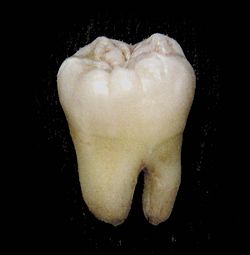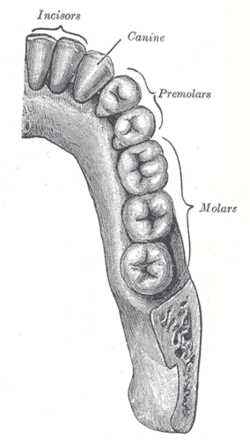Tribosphenic molar
| Molars | |
|---|---|

A lower wisdom tooth after extraction.
|
|

Permanent teeth of right half of lower dental arch, seen from above. In this diagram, a healthy wisdom tooth is included.
|
|
| Details | |
| Artery | posterior superior alveolar artery |
| Identifiers | |
| Latin | dentes molares |
| TA | A05.1.03.007 |
| FMA | 55638 |
|
Anatomical terminology
[]
|
|
The molars or molar teeth are large, flat teeth at the back of the mouth. They are more developed in mammals. They are used primarily to grind food during chewing. The name molar derives from Latin, molaris dens, meaning "millstone tooth", from "mola", millstone and dens, tooth. Molars show a great deal of diversity in size and shape across mammal groups.
In humans, the molar teeth have either four or five cusps. Adult humans have twelve molars, in four groups of three at the back of the mouth. The third, rearmost molar in each group is called a wisdom tooth. It is the last tooth to appear, breaking through the front of the gum at about the age of twenty, although this varies from individual to individual. Ethnicity can also affect the age at which this occurs, with statistical variations between groups. In some cases, it may not even erupt at all.
The human mouth contains upper (maxillary) and lower (mandibular) molars. They are: maxillary first molar, maxillary second molar, maxillary third molar, mandibular first molar, mandibular second molar, and mandibular third molar.
In mammals, the crown of the molars and premolars are folded into a wide range of complex shapes. The basic elements of the crown are the more or less conical projections called cusps and the valleys that separate them. The cusps contain both dentine and enamel, whereas minor projections on the crown, called crenullations, are the result of different enamel thickness. Cusps are occasionally joined to form ridges and expanded to form crests. Cingula are often incomplete ridges that pass around the base of the crown.
These mammalian multi-cusped cheek teeth probably evolved from single-cusped teeth in reptilians, although the diversity of therapsid molar patterns and the complexity in the molars of the earliest mammals makes it impossible to determine how this happened. According to the widely accepted "differentiation theory", additional cusps have arisen by budding or outgrowth from the crown, while the rivalling "concrescence theory" instead proposes that complex teeth evolved by the clustering of originally separate conical teeth. It is generally agreed that therian mammals (placentals and marsupials) evolved from an ancestor with tribosphenic cheek teeth, with three main cusps arranged in a triangle.
...
Wikipedia
